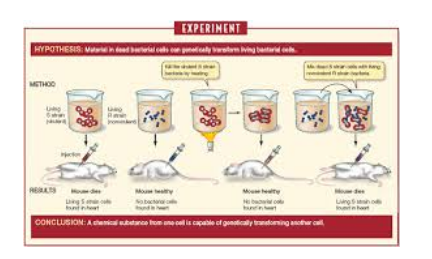Using the figure above of Griffith's experiment, the hypothesis rewritten to follow proper formatting could be: If genetic material in a dead bacterial cell can be transformed, then another living bacterial cell will inherit the material and express its traits. True False
Genetic Recombination
Recombination is crucial to this process because it allows genes to be reassorted into diverse combinations. Genetic recombination is the process of combining genetic components from two different origins into a single unit. In prokaryotes, genetic recombination takes place by the unilateral transfer of deoxyribonucleic acid. It includes transduction, transformation, and conjugation. The genetic exchange occurring between homologous deoxyribonucleic acid sequences (DNA) from two different sources is termed general recombination. For this to happen, an identical sequence of the two recombining molecules is required. The process of genetic exchange which occurs in eukaryotes during sexual reproduction such as meiosis is an example of this type of genetic recombination.
Microbial Genetics
Genes are the functional units of heredity. They transfer characteristic information from parents to the offspring.

Griffith’s experiment involved the use of two strains of pneumococcus (Streptococcus pneumoniae), a deadly virulent strain (S) and a non-virulent strain (R). The deadly virulent bacteria (strain S) contains DNA that codes for the synthesis of a smooth protective polysaccharide capsule around the bacterium. This polysaccharide capsule protects the virulent bacteria (strain S) from the host’s immune system.
- When Griffith injected the mice with non-virulent bacteria (strain R), the mice survived.
- When Griffith injected the mice with virulent bacteria (strain S), the mice died.
- When Griffith injected the mice with heat killed virulent bacteria strain (strain S), the mice survived as the heat had killed the bacteria.
- When Griffith injected the mice with a combination of heat killed virulent bacteria (strain S) and non-virulent (strain R), the mice died.
Even though in the fourth experiment, the virulent bacteria (strain S) was heat killed, the DNA present in the virulent bacteria survived the heating process. This DNA was taken up by the non-virulent (strain R) bacteria which led to its transformation, which killed the mice.
From this experiment Griffith pointed out the presence of transferable genetic material within the cell which led to transformation of the non-virulent bacteria into virulent bacteria.
The exact nature of the transforming principle (DNA) was verified in the experiments performed by Avery, McLeod and McCarty and Hershey and Chase.
Trending now
This is a popular solution!
Step by step
Solved in 2 steps









